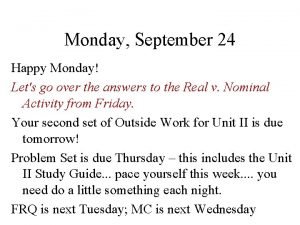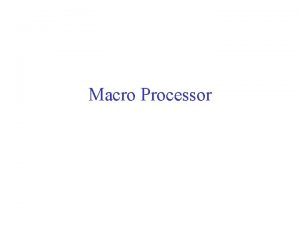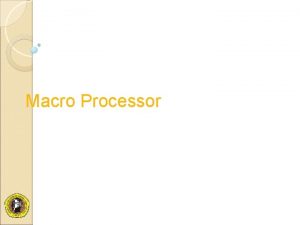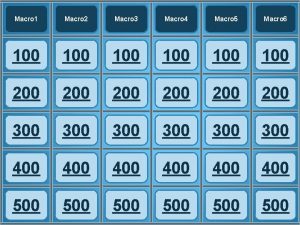IN LINE FUNCTION AND MACRO Macro is processed






- Slides: 6

IN LINE FUNCTION AND MACRO Macro is processed at precompilation time. An Inline function is processed at compilation time. Example : let us consider this C Program # include <stdio. h> inlinemax(int a, int b) { (a > b) ? a : b ; } macromax(int a, int b) { (a > b) ? a : b ; } main( ) { int a=1, b=2; inlinemax(++a, ++b); mmax(++a, ++b); }

In this program : In macromax(MACRO) , a and b are incremented twice. This is because here ++a and ++b are copied instead of a and b. In inlinemax(INLINE FUNCTION), a and b are incremented only once. -----------------------------------------------LAEXICAL ANALYSER -----------------------------------------------THE ROLE OF LEXICAL ANALYSER : It is the first phase of the compiler. It reads the input characters and produces as output a sequence of tokens that the parser uses for syntax analysis. it also stripps out from the source program comments and white spaces in the form of blank , tab , and newline characters. it also correlates error messages from the compiler with the source program. NOTE: here merging of lexical analyser and syntax analyzer is possible-----LEXICAL SYNTAX ANALYSER

Interaction of lexical analyzer withparser CREATING A LEXICAL ANALYSER WITH LEX: * Lex program (lex. l) ------->LEX COMPILER----------->lex. yy. c * lex. yy. c -------->C COMPILER ----------> a. out * input stream ---------> a. out --------> sequences of tokens

TYPES OF TOKENS : INDETIFIERS : has attributes …which contains entry point in the symbol table CONSTANTS : two types (1) integer , and (2) real KEYWORDS : (if, while , for , else) OPERATORS : * , + , (, ), RELATION : <, <=, =, <>, >, >= etc PUNCTUATIONS : , and ; and : etc LITERAL STRINGS : printf (“hello”) IDENTIFIERS : RULES : Start with a _(underscore) or alphabet followed by digit / alphabet / _ _ [digit] is a variable. _ _ _ is not a variable. _ _ _ [alphabet] is a variable REGULAR EXPRESSION FOR IDENTIFIERS : ( _ ) (alphabet / _ digit ) (alphabet / digit / _ ) *

BUILDING LEXICAL ANALYZER USING LEX TOOLS: Using lex tools one can build a lexical analyzer in an easy way. For this , A specification of a lexical analyzer is prepared by creating a program lex. l in the lex language. Then, lex. l is run through the Lex compiler to produce a C program lex. yy. c. The program lex. yy. c consists of a tabular representation of a trasition diagram constructed from the regular expressions of lex. l, together with a standard routine that uses the table to recognize lexemes. The actions associated with regular expressions in lex. l are pieces of C code and are carried over directly to lex. yy. c. Finally, lex. yy. c is run through the C compiler to produce an object program a. out, which is the lexical analyzer that transforms an input stream into a sequence of tokens. Creating a lexical analyzer with Lex.

LEX SPECIFICATIONS: A Lex program cinsists of three parts: declarations %% translation rules %% auxillary procedures The declarations section includes declarations of variables, manifest constants, and regular definitions. The translation rules of a Lex program are statements of the form p 1 { action 1 } p 2 { action 2 } …………. pn { action n } where each p is a regular expression and each action is a program fragment describing what action the lexical analyzer should take when pattern p matches a lexeme. The third section holds whatever auxiliary procedures are needed by the actions.











